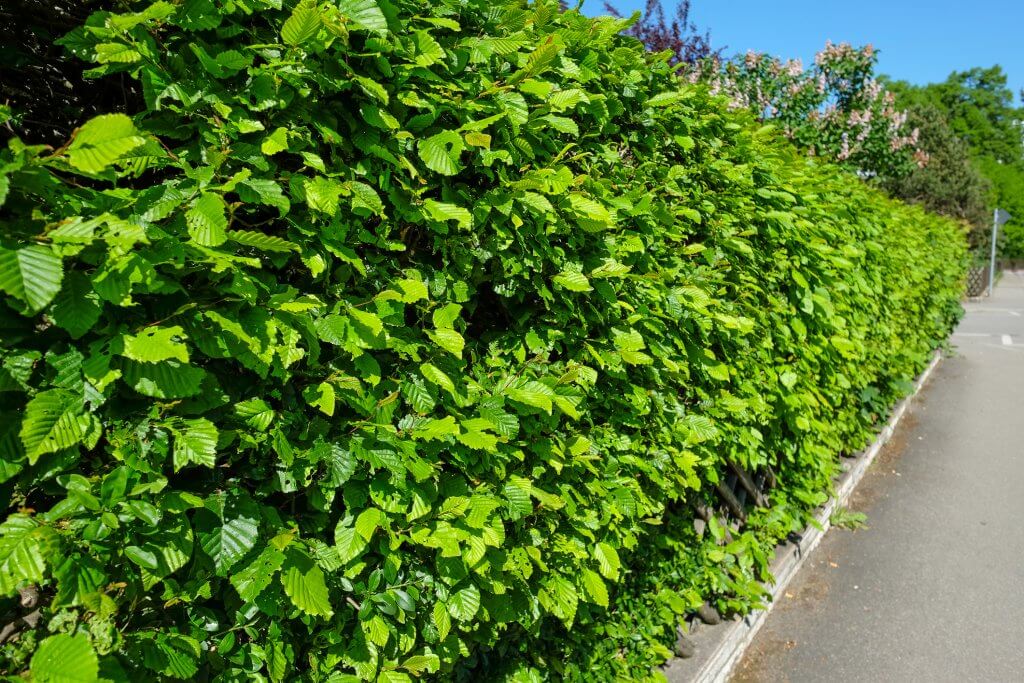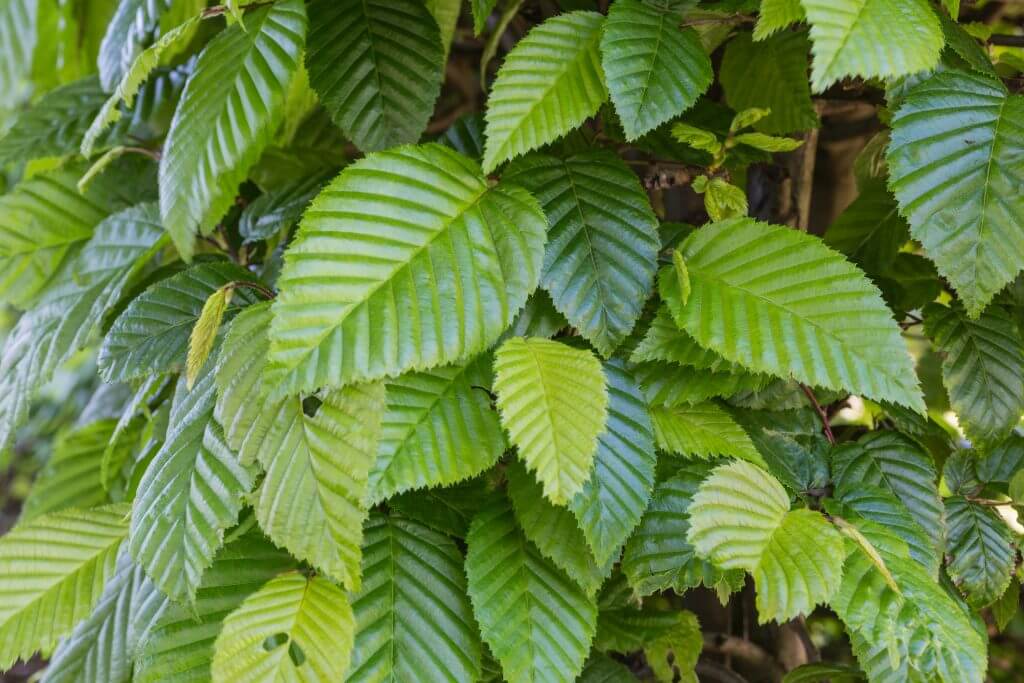The name hornbeam originated as a description of the quality of its wood—as hard as a horn; and “beam,” which is the Old English word for tree. It is a hardy hedging plant that is why it is popular for that, as well as for other ornamental and practical purposes.

Varieties of Hornbeam
Hornbeam is comprised of about 25 species constituting the genus Carpinus of the birch subfamily Coryloideae. However, some botanists groups classify them with the Corylus or hazels and hop-hornbeams or Ostrya.
- European hornbeam (Carpinus betulus)
- American hornbeam (Carpinus caroliniana)
- Asian hornbeam (Carpinus cordata)
- Japanese hornbeam (Carpinus japonica)
- Korean hornbeam (Carpinus eximia)
Many hornbeam species occur across much of the temperate regions of the northern hemisphere, with the most number of species in East Asia, particularly China. Only two species occur in Europe, only one in eastern North America, and one in Mesoamerica. The European Hornbeam can be found in Europe, Turkey, and Ukraine.


Characteristics of Hornbeams
Trunk
The European hornbeam (Carpinus betulus) is sometimes considered in some cultures as mystical, owing to its whitish, twisted trunk which branches profusely. The American hornbeam (Carpinus caroliniana) is known as water beech or can have a blue-grey bark and is commonly identified as blue beech.
The hornbeam is also sometimes called “ironwood” because of its very hard timber. It is rarely, if at all, used for general carpentry because of the challenge in working such a tough wood. However, some do use the hornbeam wood for things that need to be durable, such as parquet flooring, gears, and pegs in simple machines. It could also be coppiced to serve as hardwood poles.
American hornbeam has a smooth trunk with a muscular or sinewy appearance, which divides into slender and slightly pendulous branches.
Size
Hornbeam sizes could vary depending on the region. European hornbeams can grow up to a height of 32 metres, classifying them as small to medium-sized. Its American counterpart, however, rarely grows more than 12 metres, although some may grow up to 18 metres especially in the southern part of the United States. Asian species could grow up to 15 metres high, and the Japanese and Korean variety usually grow about 9 metres tall.
Leaves
Colour – Generally, the leaves are the most distinctive part of the hornbeam tree. They are bright and verdant during spring and summer, and in autumn through winter, they turn rust-coloured. The hornbeam’s leaves are deciduous, which means they do shed annually. But it takes a little longer than most, adding a splash of vibrant colour to the surroundings during the winter season. Hornbeam leaves fall later, especially for hornbeams planted and managed as a hedge.
Shape
Some people mistake the hornbeam tree for birch, but the European hornbeam’s leaves have a serrated margin, which makes it a bit more corrugated and distinguishes it from that of the birch tree’s. American hornbeam leaves are egg-shaped and are white-haired when it is unfolding. The Asian species have heart-shaped leaves, and the Korean hornbeam has egg-shaped, slender and downy leaves. The leaves have sharp double-toothed margins, and pairs of parallel veins. The hornbeam leaves are hairless, except for a few appressed hairs on the main vein below.


Fruit and Pollination
Hornbeams are monoecious, meaning a single tree will produce both male and female flowers. They produce pendulous catkins in the spring, with the male and female flowers in separate catkins. Male catkins are about 2.5-5 cm long, and the females about 2 cm.
The bract is slightly asymmetrical and could either be a simple oval for the male or trilobed for the female. The bract holds the fruit, which is a small nut about 3-6mm long. Each catkin could have around 10-30 seeds. The asymmetry of its seeds wings contributes to better dispersal as it spins while it falls.
In addition to the leaves’ characteristics, identification of hornbeams could also be made through the shape of the seed wings.
How to Plant and Care for Hornbeam
Hornbeams are hardy and resilient as adults, but seeds and seedlings need a little more care and attention.
Soil Conditions
Hornbeams prefer organically fertile soil that holds moisture. It also minimises the need for supplemental watering. More mature hornbeams can tolerate more extended periods without watering, but younger ones need regular irrigation, especially in dryer seasons.
For growing hornbeams from seeds, the ideal is loam soil—a mix of organic matter, clay and silt.
Planting
Some people would prefer to plant hornbeams from seedlings purchased from a nursery. But if they have the patience and dedication, it is possible to grow hornbeam from seeds.
Gathering and preparing hornbeam seeds:
Hornbeam seeds will have a better chance of germinating when planted as soon as the seeds fall, which is in autumn. Dried and stored hornbeam seeds tend to go dormant.
- Soak the gathered hornbeam seed clusters in water for about 8 hours.
- Crush the seed to release the smaller seeds.
- Discard any seed that floats to the top.
Planting hornbeam from seeds
- Prepare 5-inch pots with loam soil.
- Plant 2 seeds per pot.
- Put a layer of compost on top
- Water when the compost feels dry
- The seeds will germinate in early spring
- Keep the seedlings in a partially shaded place
After the seeds germinate in spring, the seedlings will be ready for transplant in summer.
- Choose a location outdoors that is a little warmer and brighter than the previous area, but not direct sunlight.
- The spacing of the hornbeam would depend on the purpose, usually around 7 metres apart, or a little closer if the hornbeams will be used as hedges, sometimes even down to 2 metres apart for a denser hedge.
Fertilisation
Good soil will also eliminate the need to fertilise the plant or tree. Fertilisation may be necessary when the foliage is pale, or if the tree is not growing as well as it should. During winter, more fertiliser may be needed.
Pruning
Hornbeam clips easily and is even used for decorative purposes like the Japanese bonsai. For young and full-grown hornbeams, the need to prune depends on the goal of planting hornbeams. For overall good health, the tree will not require much pruning. Because it is a hardy tree with strong branches, it seldom needs any repair.
The usual maintenance requirement for hedges may be applied to hornbeam hedges.


Common Problems of Hornbeams
Hornbeams are usually resilient and hardy, but just like other plants, there could be some problems encountered, from those that are just annoying or unsightly to more severe issues that could threaten the health and the life of the plant.
The following are some issues for the hornbeam and suggested methods to combat them.
Decay Fungus and Heart Rot
Decay fungus and heart rot on European hornbeams affect its life by compromising its structural support. This is extremely dangerous because the infection may not be visible from the outside, unless the tree gets a cut that could reveal the rot from the inside of its trunk. Not only is this dangerous for the life of the tree itself, but it will be a hazard that could cause damage to other properties nearby, or even cause injury to people.
Prevention
To protect the hornbeam against decay fungus and heart rot.
- Protect hornbeam from injury.
- Remove dead branches as soon as possible.
- Treat pests and other issues before they worsen.
- Water regularly (a healthy and not water-stressed tree will less likely develop the disease)
Root rot
Hornbeams are susceptible to root rot and oak root rot (also known as Armillaria root rot or oak root fungus). This is a serious problem if left untreated because it will lead to the death of the root and trunk.
Symptoms:
- Discoloured leaves
- Premature falling of the leaves
- Branches near the top may begin to die.
- Mushrooms growing near the base may also be an indication of fungi growth in the root.
Prevention:
- Proper irrigation
- Good drainage in the soil
Powdery mildew
Powdery mildew is also a fungal disease that affects different species of trees and other plants. This is highly contagious and could infect other plants through spores.
Symptoms:
- White powdery substance coating the foliage, flowers, stems and other parts of the plant
- Discolouration of the leaves, from yellowing to browning
- Premature falling of the leaves
Prevention:
Be vigilant and take care that plants are not subjected to excessive moisture and humidity, especially plants located in shaded areas, as this is the perfect condition for the growth of the powdery mildew.
Treatment:
For European hornbeams already infected by powdery mildew, the application of sulphur or copper fungicide on a calm and cool day may help treat it.
Canker Disease
As in the other hornbeam diseases, canker could cause the death of the plant or tree if left untreated
Symptoms:
- Sunken area containing dead tissue in the trunk, branch or stem
- Discolouration of the leaves on the infected stem or branch
Prevention:
Regular pruning, especially of the deceased or dying branches, leaves and twigs, can help prevent canker disease.
Treatment:
Create cuts on healthy parts of the wood away from the cankers. Pruning will not be of much help if the canker infects the main trunk. To treat this, apply an all-purpose, slow-release fertiliser or organic fertiliser to help improve the plant’s overall health, and help it fight off the cankers. Take care not to over-fertilise.
[elementor-template id=”4604″]
[elementor-template id=”6387″]
